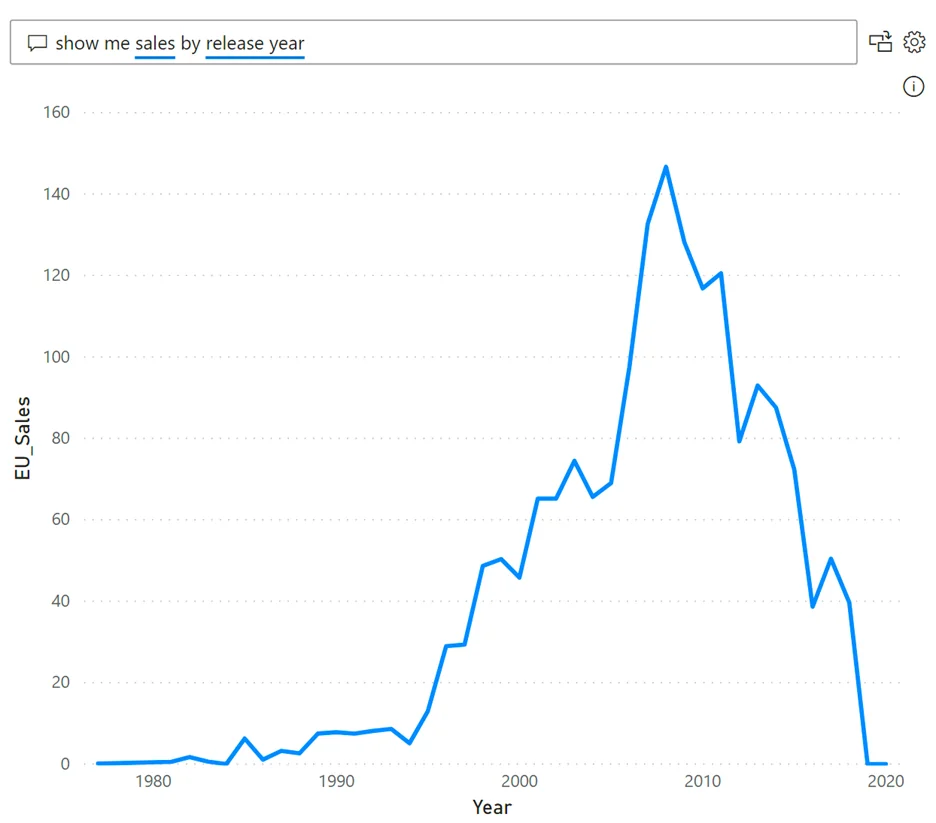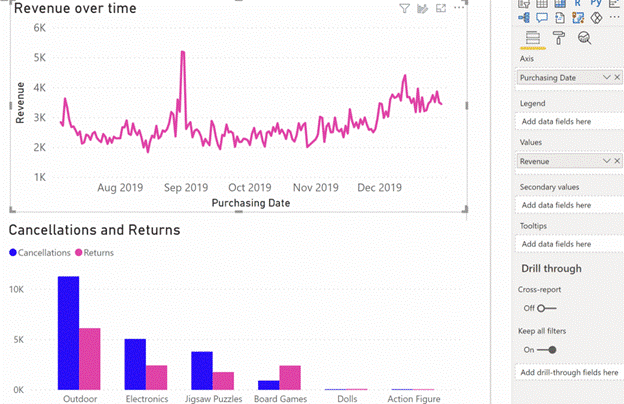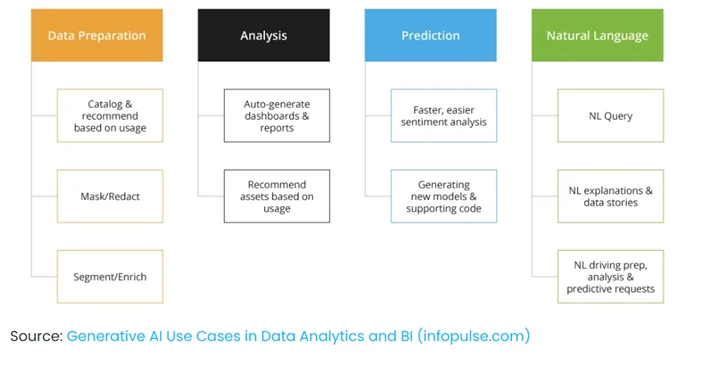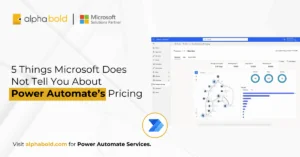Table of Contents
Introduction
Decision-makers often struggle to turn large datasets into actionable insights. Power BI AI features automate data analysis, highlight trends, and generate predictive insights, helping executives and analysts make faster, more informed decisions.
Consider these recent findings:
- 44% of company owners see AI as essential for decision-making.
- 79% of businesses already use AI to inform strategic decisions.
- 92% support AI to improve decision-making efficiency.
- 96% of CEOs are optimistic about AI’s role in guiding data-driven strategies.
With these trends, adopting AI-driven analytics in platforms like Power BI is no longer optional; it’s a strategic necessity. Organizations leveraging these tools gain faster insights, better forecasts, and measurable improvements in business performance.
How Power BI AI Features Drive Smarter Insights?
Organizations struggle to turn complex datasets into actionable insights. Power BI integrates advanced AI capabilities, such as predictive analytics, natural language queries, and anomaly detection, to streamline data analysis and automate key decision-making processes.
- Power BI connects seamlessly to cloud, on-premises, and spreadsheet data sources. Using Power Query, users clean, transform, and model data for in-depth analysis, all within a unified platform.
- Dynamic charts, interactive dashboards, and AI-powered visuals help users detect trends, identify anomalies, and highlight key business drivers. Machine learning and predictive analytics make these insights actionable in real time.
- Data Analysis Expressions (DAX) enable sophisticated calculations and precise queries, empowering teams to extract meaningful insights. Combined with AI features, Power BI supports data-driven strategies for organizations of all sizes.
By leveraging AI in Power BI, organizations gain faster reporting, better forecasting, and smarter insights, remaining competitive in a rapidly evolving data-driven market.
Why AI in Power BI Critical for Business Insights?
Applying the Pareto Principle to data analysis, AI helps focus on the 20% of tasks that deliver 80% of insights. By automating repetitive tasks, Power BI allows teams to concentrate on high-impact analysis, improving forecasting, trend detection, and overall decision-making efficiency.
With these AI-driven capabilities, organizations gain faster reporting, more accurate predictions, and actionable insights, ensuring they remain competitive in an increasingly data-driven market.
Key Capabilities
- Seamless Data Integration: Connect to cloud, on-premises, and spreadsheet sources. Use Power Query to clean, transform, and model data for in-depth analysis, all within a unified platform.
- Democratized AI for All Users: Automated insights, natural language queries, and advanced data modeling allow users of all skill levels to access and interpret data efficiently.
- Dynamic Visualizations & AI Insights: Interactive dashboards, charts, and AI-powered visuals detect trends, anomalies, and key business drivers in real time.
- Advanced Analytics with DAX: Data Analysis Expressions (DAX) enable precise calculations and complex queries, supporting deeper insights.
These Power BI AI features democratize data analysis, making it accessible to users of all skill levels and empowering them to derive meaningful insights with ease.
How Power BI AI Features Redefine Data-Driven Decision-Making?
When employees can use AI to accelerate business performance, data becomes more than a reporting tool; it becomes a decision-making engine. Power BI integrates advanced AI features such as Natural Language Queries (NLQ), Quick Insights, and Key Influencers, empowering teams to uncover insights faster and make confident, data-backed choices.
These Power BI AI features reduce the dependency on technical expertise. Instead of manually building queries or reports, users can ask questions, detect trends, and visualize outcomes with minimal effort.
Below are the most impactful AI-driven features in Power BI that are changing how organizations interpret and act on their data.
1. Natural Language Query (NLQ):
Power BI’s Natural Language Query (NLQ) feature transforms how users interact with data by replacing technical queries with simple, conversational language. Users can type questions in plain English, such as “What were the top-performing products last quarter?” and receive accurate, visualized results instantly.
Powered by machine learning, NLQ understands context and intent, making data analysis accessible to non-technical users while maintaining precision and speed.
Key Highlights:
- Conversational search: Ask data questions in natural language without coding or formulas.
- AI-driven query refinement: Power BI highlights recognized (blue), unclear (orange), and unrecognized (red) terms to improve accuracy.
- Smart recommendations: The system suggests related questions or terms to guide deeper exploration.
- Instant visual insights: Integrated with Quick Insights, it automatically generates charts, maps, and tables to reveal underlying trends.
- Inclusive access: Enables every employee, from analysts to executives, to extract insights independently.

2. Anomaly Detection:
Power BI’s Anomaly Detection feature automatically identifies unexpected patterns or data deviations within time-series datasets. It enables organizations to detect irregular trends, such as sales drops, traffic spikes, or performance fluctuations, without manual filtering or complex modeling.
This AI capability not only flags anomalies but also provides contextual explanations, helping teams pinpoint underlying causes and respond proactively.
Key Highlights:
- Automated pattern recognition: Scans datasets to flag deviations that fall outside expected performance ranges.
- Customizable sensitivity: Adjust detection thresholds to capture the most relevant anomalies.
- Root-cause explanations: The Insights Pane details contributing factors ranked by impact.
- Visual clarity: Highlights anomalies directly within dashboards for quick action.
- Mobility-ready: Integrated with Power BI’s mobile apps for real-time alerts and monitoring from anywhere.

3. Key Influencers:
Power BI’s Key Influencers visual helps organizations uncover the “why” behind their data by identifying the most significant factors influencing outcomes. This AI-driven capability goes beyond descriptive analytics to deliver explanatory insights, showing how variables interact and contribute to business performance.
Whether assessing revenue fluctuations, customer churn, or operational inefficiencies, Key Influencers pinpoints the metrics and attributes most correlated with success or risk.
Key Highlights:
- Driver analysis: Automatically identifies variables that have the strongest statistical influence on a selected metric, such as sales growth or satisfaction ratings.
- Impact ranking: Displays a ranked list of top influencers along with quantitative impact scores to help prioritize business actions.
- Advanced relationships: Recognizes both linear and non-linear correlations, giving a more holistic understanding of what’s shaping business outcomes.
- Visual clarity: Presents results through intuitive charts and comparison visuals, allowing decision-makers to interpret insights at a glance.
- Accessible for all users: Designed for non-data scientists, enabling teams to explore causal relationships without needing deep technical expertise.

4. Decomposition Tree:
The Decomposition Tree in Power BI enables users to break down complex metrics into smaller, more understandable components. It’s an AI-assisted visualization that helps businesses identify which factors contribute most to a particular outcome, be it revenue, customer satisfaction, or production efficiency.
This tool combines human exploration with machine intelligence. Users can start with a single metric (e.g., total sales) and progressively expand nodes to see contributing factors like region, product line, or sales channel. Power BI AI features then recommend the next most impactful dimension to explore, making the analysis process both intuitive and efficient.
Key Highlights:
- AI-guided exploration: Automatically suggests which data dimension has the greatest effect on your target metric.
- Interactive breakdown: Lets users dynamically drill down through categories such as geography, product, or department.
- Customizable visuals: Offers options to sort, filter, and color-code nodes for better readability and engagement.
- Cross-platform flexibility: Available in both Power BI Desktop and the Power BI Service, supporting real-time collaboration and report sharing.
- Contextual analysis: Supports hierarchical data modeling, helping analysts connect operational and financial metrics seamlessly.

5. Sentiment Analysis:
Sentiment Analysis in Power BI helps businesses move beyond numbers by interpreting customer emotions and opinions hidden within text data. Using Natural Language Processing (NLP), this AI capability scans customer reviews, feedback forms, or social media comments to determine whether the sentiment is positive, negative, or neutral.
This allows organizations to assess not only what customers say but also how they feel, providing actionable insights to improve experience, product quality, and communication strategies.
Key Highlights:
- Emotion detection: Identifies tones such as satisfaction, frustration, or enthusiasm to give deeper context behind customer interactions.
- Real-time text analytics: Processes unstructured text from multiple data sources, emails, surveys, chat logs, or social platforms.
- Custom sentiment models: Allows data scientists and analysts to tailor models to industry-specific needs (e.g., “support ticket urgency” or “purchase intent”).
- Integration-ready: Works seamlessly with Power BI’s data flows, Azure Cognitive Services, and Power Automate for end-to-end analysis.
- Visualization support: Converts text-based insights into visual dashboards showing sentiment distribution and trend shifts over time.
Get Expert Help for Power BI Implementation and Support
Enable predictive analytics and real-time insights by integrating AI capabilities with your Power BI reports. We help enterprises automate data analysis and enhance decision accuracy across all departments.
Request a Demo6. AI-Powered Forecasting:
The AI-powered forecasting enables organizations to transform historical data into forward-looking insights. By applying machine learning algorithms to time-series and real-time data, it automatically identifies seasonal patterns, trends, and fluctuations that might otherwise go unnoticed.
This feature helps decision-makers anticipate market shifts, demand variations, and operational risks with greater accuracy. Forecasting visuals come with dynamic reference lines that update as new data streams in, ensuring that projections remain reliable and current.
Key Highlights:
- Predictive modeling: Uses machine learning to detect complex, non-linear patterns across datasets.
- Adaptive forecasts: Continuously refines predictions as new data is added.
- Anomaly awareness: Identifies irregularities that might affect future performance.
- Business impact: Ideal for forecasting sales, inventory needs, and customer demand trends.
7. Quick Insights:
Power BI’s Quick Insights simplifies the discovery of patterns and trends across large datasets. With a single click, it runs automated analyses using AI algorithms, producing interactive visualizations that highlight outliers, correlations, and key metrics.
The process is seamless: select your dataset, choose “Get Quick Insights,” and Power BI instantly surfaces insights, no setup or data modeling expertise required. Once generated, visuals can be reviewed, customized, and pinned to dashboards for continuous monitoring.
Key Highlights:
- Instant analysis: Generates visual summaries without manual query building.
- Pattern detection: Highlights hidden relationships and unusual data behavior.
- Ease of use: Ideal for executives and non-technical users who need quick clarity.
- Visual exploration: Offers ready-to-use charts, graphs, and trend visuals.
To maximize Quick Insights accuracy, ensure that your data model is structured and clean. The better the data quality, the sharper and more actionable the AI-driven results.

8. Azure Cognitive Services:
Power BI integrates seamlessly with Azure Cognitive Services, giving users access to pre-trained AI models that enhance analytics with capabilities like text recognition, image tagging, and language translation. This integration brings enterprise-grade AI functionality into Power BI reports, without requiring any custom code or model training.
Through APIs and containers, these services can be deployed in both cloud and on-premises environments, enabling flexible and scalable AI adoption.
Key Highlights:
- Language detection: Automatically identifies over 120 languages for global datasets.
- Text analytics: Extracts key phrases, topics, and sentiment from unstructured data.
- Image recognition: Tags and classifies over 2,000 objects within images.
- Emotion analysis: Interprets human sentiment and tone from short text samples.
- Customizable integration: Works within Power BI dataflows and Power Automate pipelines.
By embedding Azure Cognitive Services into Power BI, businesses can streamline data enrichment, reduce manual processing, and enhance reporting precision. For example, a global retailer can use language recognition and sentiment analysis to interpret multilingual feedback, providing unified insights across markets.
If you’re looking for Power BI consulting expertise, learn The Value of Consulting Expertise in Power BI Implementations.

Optimize Your Power BI Setup with On-Demand Services
From troubleshooting to model optimization, our on-demand Power BI services ensure you get the most from every dataset, without overhauling your entire system.
Request a DemoConclusion
AI is changing how businesses work with data, and Power BI is making that shift practical. With data coming in from every direction, teams need more than dashboards; they need answers. Power BI’s AI features make it easier to spot trends, cut through noise, and act fast. It helps decision-makers focus on strategy instead of manual reporting and turn everyday data into clear next steps.
FAQs
Not at all. Power BI’s AI and natural language features make it easy for any business user to ask questions and generate insights without coding or deep analytics skills.
Consulting ensures your reports align with KPIs, governance, and scalability goals. Experts help eliminate data silos, optimize performance, and design models that support long-term analytics growth.
Yes. Power BI integrates directly with Azure Machine Learning and Cognitive Services, allowing you to import, train, or deploy models for custom business scenarios such as churn prediction or demand forecasting.
AI in Power BI uses proven Microsoft algorithms for accuracy. However, consulting experts fine-tune data models and validation processes to ensure that AI recommendations align with your business logic.
Yes. All AI processing in Power BI is protected under Microsoft’s enterprise-grade security and compliance framework, ensuring sensitive information remains within your organization’s governance boundaries.
Explore Recent Blog Posts










